AP World Review Notes
Exam: May 11, 2023
Heimler’s History review List of study guides
Unit 1
1.1– Song China
Song China in 1200-1450 was powerful
Song Dynasty state structure had several departments
imperial bureaucracy
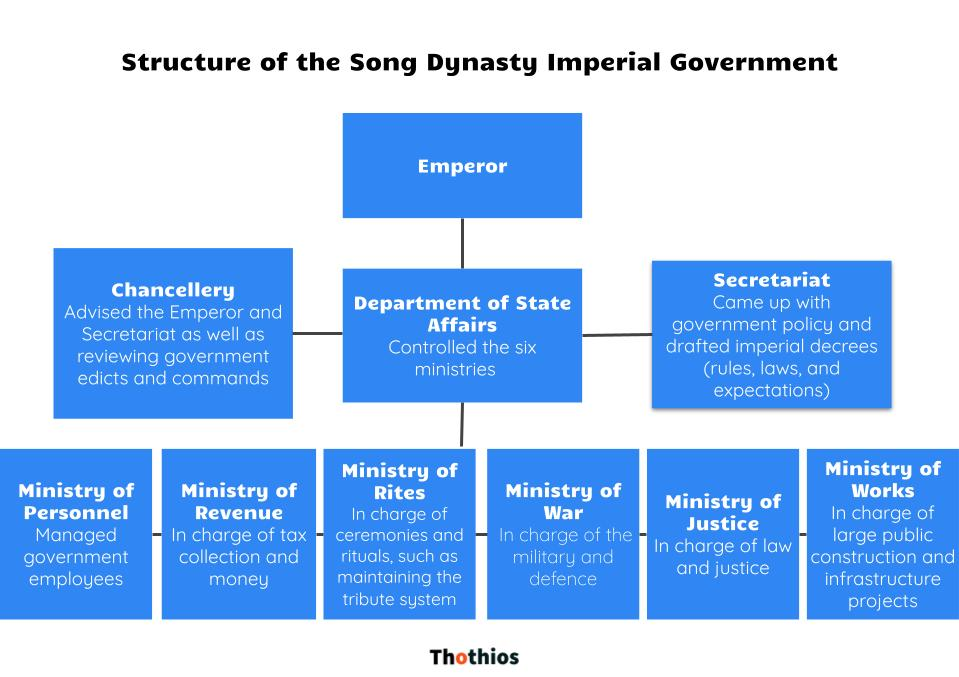
Confucianism-- hierarchical worldview (everyone has their place)
Civil Service Exam enforced it & created a higher scholarly class
Wide trade across Afro-Eurasia, commercialized Chinese society
Innovation
large iron industry
creation of paper money
artisanal labor for textiles & porcelain
invention of gunpowder (used for fireworks & military)
champa rice
Grand Canal (transportation/trade)
New forms of Buddhism
Effects on other countries-- Japan (tried to stay independent) & Korea
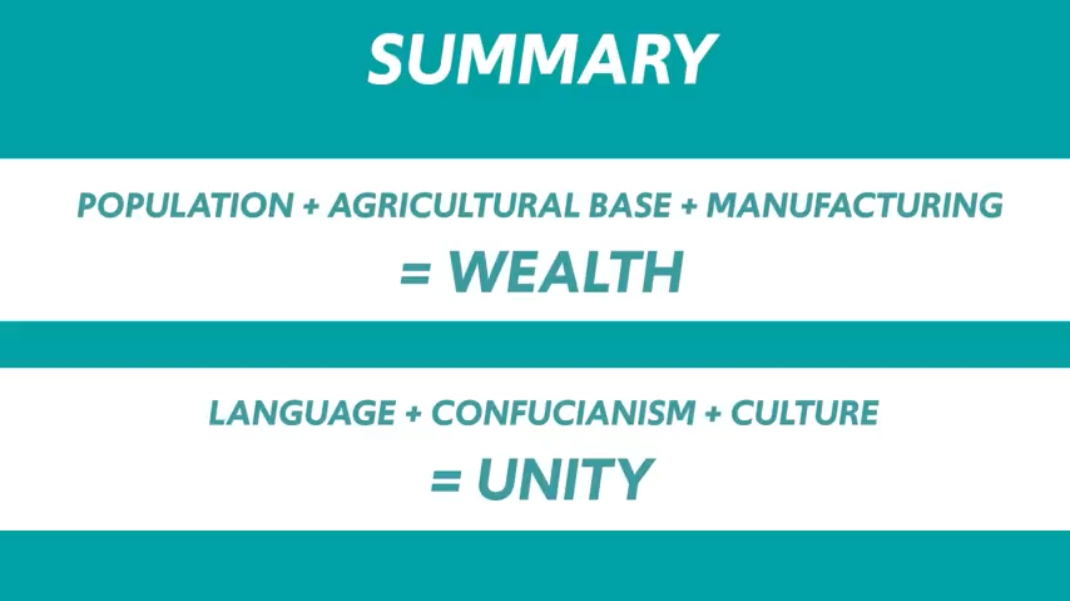
1.2– Dar al-Islam
Islamic Abbasid caliphate rose, but began to fracture
united by Arabic/Islamic traditions
South Asian Delhi Sultanate established (Islam spread by Turks)
conflict between Hinduism & Islam
Muslim missionaries— Sufis appealed to Hindus (especially lower castes)
West African Islam spread through travelling merchants
Mansa Musa
Economics
merchants/economy was valued by Muslims
dominant in trade —> created forms of banking, credit, business contracts, etc.
Technology
improved rockets & papermaking (Chinese)
translating Greek & scientific/other texts
House of Wisdom
1.3– India & South East Asia
South Asian state building
Hinduism —> Islam —> Buddhism
Hindus had most power, Muslims wanted to expand
Delhi Sultanate brothers converted for power & created Vijayanagara Empire
Bhakti Movement
emotional side of Hindu devotion, emphasized one god
similar to Sufi Muslims
Rigid caste system divided society hierarchically (long continuity)
Advances made with Middle East
South East Asian state building
Hinduism —> Buddhism —> Islam (all brought from merchants)
Sea-based powers (like Majapahit Empire) controlled sea routes
Land-based powers (like Khmer Empire) controlled agriculture
1.4 + 1.5– the Americas & Africa
North American state building
Mississippian culture— built monumental mounds
rigid class system (Great Sun —> priests/nobles —> other)
Southwest American state building
arid land, brick houses
Central American state building
Aztec capital city Tenochtitlan was prosperous (built on water)
used tribute system (like a tax for being conquered) to establish wide political dominance
African state building
sub-Saharan Africa agriculture was prominent
no centralized government— small, kin-based networks with chiefs & councils
Hausa Kingdom had several states with specialized purposes (agriculture, military, etc.)
trans-Saharan trade routes spread Islam
oral literature— griottes told stories of lineage
1.6– Europe
Roman Empire fell —> Byzantine Empire
Europe was divided between small kingdoms
Feudalism— classes have obligations
serfs were tied to the land & the lord
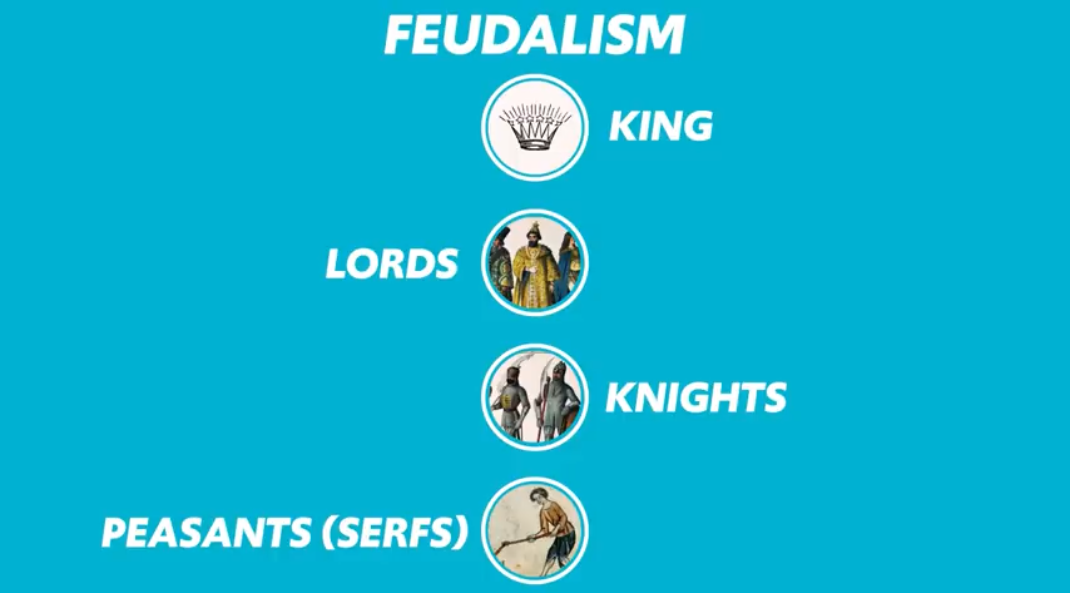
Dark Ages— decline of trade, standard of living, intellectual life
High Middle Ages— rise of powerful kings (less power to feudal lords)
established large bureaucracies
put together huge standing armies
Noble class gained power again
Magna Carta— noble class was guaranteed rights
established English parliament
Roman Catholic Church persisted
established first universities (philosophers/thinkers/educators were religious)
art had religious themes (combatted illiteracy)
Church vs. State tensions
Crusades— Christians wanted to reclaim Jerusalem from the Muslims; shifted power to the church
Marco Polo went to China & spread the culture to Europe (innovations in cartography)
Bourgeoisie (middle class) developed— shopkeepers, merchants, small landowners
Small Ice Age impacted agriculture —> smaller population —> less trade —> falling economy
Renaissance (rebirth)— Greek/Roman culture, art, & literature
Summary:
State building— a state is an organized political community under one government
China’s Golden Age (developed technology)
food technology = growing population
Delhi Sultanate (hard to convert Indians to Islam)
Egyptian Mamluk Sultanate was a slave empire
non-Muslims forced into military overthrew the government
Vijayanagara Empire & Chola Kingdom in India used trade
Mali Empire in Africa used centralized power to gain incredible wealth
Aztecs in America ruled indirectly with tribute system
Incans used mit’a system to enforce mandatory public service
Europeans shifted from feudalism to monarchy
Religion
Islam used shared beliefs and language to unite
Confucianism allowed Song China to justify their rule (Civil Service Exam)
Hinduism & Buddhism spread in South/South East Asia
caste system consolidated power
Roman Catholic Church organized society separately from the state (states were weak and divided)
church vs. state
Conversion through missionaries or military (for opportunities); trade facilitated conversion
Technology
Champa rice from Vietnam helped China
Paper making increased literacy across Afro-Eurasia
more learning of medicine & math
House of Wisdom— studied & translated old texts
Nomads
pastorals in Central Asia controlled a huge empire & created political stability/safer trade
influence of nomads decreased (less role in trade)
Unit 2
2.1, 2.3, 2.4– Silk Road, Indian Ocean, Trans-Saharan
Silk Road— from China to Europe & North Africa
transport of luxury goods, especially Chinese silk
spread culture (like Buddhism) through merchants; cultures changed (like new forms of Buddhism)
transferred diseases to people without immunity
Black Death— heavily impacted Europe, China, & Islamic regions
Indian Ocean— from China to East Africa; linked societies by sea
largest sea-based system ever at the time
ships could transfer more goods for cheaper, so more trade of common goods as well as luxury goods
porcelain = China; spices = Southeast Asia; cotton/pepper = India; ivory/gold = East Africa
Technology: monsoon winds, magnetic compass, astrolabe, Chinese junks
Spread of culture
Srivijaya Kingdom in Southeast Asia created competition (Strait of Malacca was shortest route)
Swahili city-states urbanized Africa; Islam spread
Trans-Saharan— linked North Africa & Mediterranean with inner Africa
variety of goods = more trade
use of camels made trade easier
Mali Empire had trade & taxes; social hierarchy formed
Causes of increased trade
Tang & Song Dynasties in China created economic prosperity
spread of Islam promoted trade
2.2– Mongol Empire
Mongols were the most significant pastorals
largest land-based empire in all of human history
little cultural impact (no new language, religion, or lasting civilization)
Genghis Khan— ruler of Mongol Empire
united fractured Mongol tribes; became chief of his followers
strength in his brutality & military
carefully organized his army to effectively control his troops (creating fierce loyalty)
had religious tolerance
incorporated conquered peoples into his tribes
expansion of Mongols began with invading China
grew to accommodate locals
united China (Chinese believed Mongols followed the Mandate of Heaven); Mongols used the same administration & taxation
Yuan Dynasty— improved roads, canals, education, & art
Mongols were eventually driven out
Conquest of Persia
Muslim Persians were slaughtered (sacking of Baghdad)
Mongols were influenced by Persians (used their administrative system)
many converted to Islam
Mongols slowly disappeared/assimilated
2.5– Cultural Consequences of Trade
Religion spread to new places— either unified the people or syncretized
Buddhism & Neoconfucianism underwent sycnretism
Muslim merchants spread Islam —> creation of Swahili language
Medical advances & technological advances in ships (lateen sail, stern rudder, compass, astrolabe, etc.)
Urbanization and growth of cities
Travelers/merchants
Marco Polo— travelled with Chinese, spread stories to Europeans
Ibn Batutta— journals of travels impacted Muslims
2.6– Environmental Consequences of Trade
Agriculture
merchants spread crops— Vietnamese Champa rice led to Chinese population growth & terrace farming
Indonesian bananas in Africa allowed populations to migrate
increased population —> environmental degradation
Little Ice Age in 1300s harmed environment
Disease
Black Death— trade routes (caravanserai) & Mongols spread the fleas
lords’ demand for labor led to workers’ rights in Europe
Summary:
Trade routes: Silk Road, Indian Ocean, Trans-Saharan
facilitated by large states (Mongols)
new technology for trade
cultural (spread of religion) and environmental (agriculture/disease) exchange
growth of cities, especially on trade routes
Promotion of travel
Better wages in Europe after Black Death
Mongols were strongest, largest empire (from China to the west)
Pax Mongolica
began trend of centralization
Unit 3
3.1– Empires Expand
Gunpowder Empires used firearms to control/expand large territory
Russia, Ottoman Empire, Safavid Empire, & Mughal Empire
Europe was recovering
printing press
monarchies centralized power
controlled taxation, military, & religion
bureaucracy— government officials that execute orders
middle class grows
Ming Dynasty in China restored Great Wall of China —> Qing Dynasty expanded
Islamic Empires
Ottomans were the strongest Islamic empire
conquered Constantinople
Safavids supported Shi’a Islam, not Sunni (caused conflict with Ottomans)
Mughals were very prosperous
Gunpowder empires fell because they didn’t modernize economically & militarily
3.2– Administration of Empires
Europe used divine right to consolidate power
Justices of the Peace settled local disputes & executed rules
English Bill of Rights gave freedoms to the people
France had absolutism (Versailles)
East Asia
Ming Dynasty got rid of Mongols— reestablished civil service exam & bureaucracy
Japanese system was feudal-like
daimyo (aristocrat) —> samurai (paid warriors)
Japan unified with Tokugawa Shogunate— shogun watches over daimyo
Islamic Empires
Ottomans used tax farming & devshirme— slaves from territories for military & officials; janissaries were elite soldiers
Mughal Empire collected taxes with zamindar
Religion, art, & architecture legitimized rule
Songhai Empire used Islam
India used Taj Mahal
Ottomans used mosques
France used Versailles
3.3– Belief Systems
Roman Catholic Church
used to provide stability, but rise of monarchies took over
corruption of Church (selling sin absolution & church offices) —> Martin Luther’s 95 Theses spread by printing press
Protestant Reformation split church & state, Church began to repair its corruption
Islamic dispute
Shi’a Safavids & Sunni Ottomans had major conflict
Mughal Empire was very religiously tolerant (led to development of Sikhism)
Summary:
How did land-based empires gain & maintain power?
consolidated & legitimized power (“I’m in charge, here’s why”)
Power
centralized government with bureaucracy (group of people who carry out will of the ruler)
helps with collecting taxes— Aztecs used tribute system to rule indirectly
strong military
gunpowder & other weapons
elite soldiers (e.g. janissaries)
religion
caliphs (successor to Muhammad), divine right, conversion to Islam
Protestant Reformation
Ottoman Sunni vs. Safavid Shi’a
art & architecture
portraits of rulers
giant structures (e.g. Taj Mahal, Versailles)
Unit 4
4.1– Technological Innovations in Sea-Based Empires
hard for Europeans to establish trade —> wanted new route to Asia —> new ship technology
Portuguese created caravel (small, fast, carried lots of cargo)
Dutch created fluyt (only made for trade, could carry a lot of cargo, cheaper)
4.2– European Exploration
States sponsored exploration for Gold, God, & Glory
mercantilism— maximize resources & profit
Christian missionaries
wanted large empires; competition
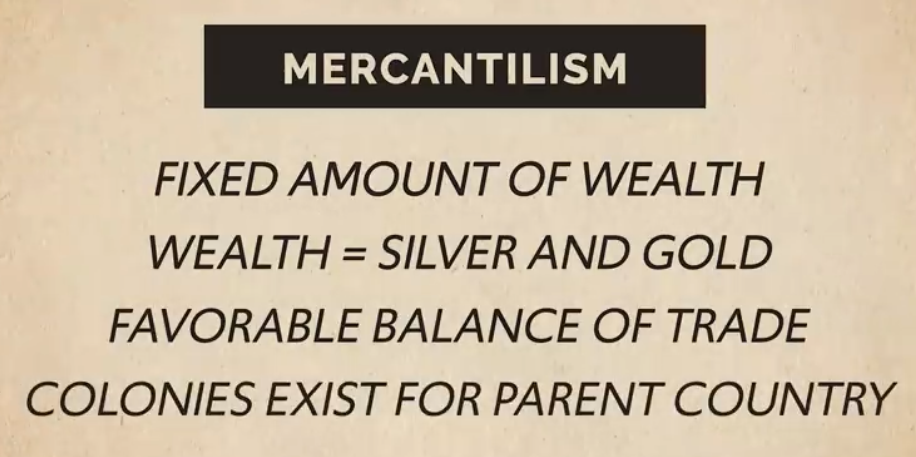
Trading-post Empire— small bits of land in strategic locations around Afro-Eurasian coast
Portuguese
Bartholomew Diaz— sailed to tip of Africa
Vasco de Gama— sailed around tip of Africa to India & claimed India
some Chinese converted to Christianity
trading-post empire, monopoly on spice, charge for trade through posts
Spanish
Ferdinand Magellan— went around South America to the Philippines
Christopher Columbus— found gold & silver in Aztec & Incan empires
English
John Cabot— found North America
established Jamestown
French
found Canada had lots of natural resources
established Quebec & trading posts with the natives
Dutch
Henry Hudson— found Hudson River & New Amsterdam
4.3– Columbia’s Exchange
Columbian Exchange— transfer of people, animals, plants, & diseases
merged Eastern & Western hemispheres
harmed natives & benefited Europeans
Diseases
isolation of the natives meant they had no immunity
smallpox— caused large-scale death of natives
Animals & food
Europeans sent pigs, cows, wheat, grapes, etc. to Americas; changed diets
introduction of horses to America changed native lifestyles (easier to hunt, military)
Europeans gained cacao, maize, & potatoes; led to population growth
Agriculture & labor
Europeans used the natives as slaves to harvest gold/silver
Brazilian slaves were familiar to their land & escaped
Trans-Atlantic slave trade
imported African slaves (Kongo kingdom)
African population still grew because of the Columbian Exchange
large-scale agriculture & dense populations —> deforestation, soil depletion, pollution, & water depletion
4.4– Maritime Empires Established
Africans + Portuguese
trading posts had local leaders
traded with Africans (firearms for slaves)
led to conflict with tribes
slave trade led to economic & cultural gains
Kongo had Christian influence
Japan isolated itself from Europeans
merchants & missionaries had little influence, but Japan soon cut off trade anyways
British began trading posts in India— British East India Co.
used Muslim vs. Hindu conflict to their advantage
Spain & Portugal fought for control in the Americas
Treaty of Tordesillas split the world in half for Spanish & Portuguese rule
Indian Ocean trade shifted from culturally-controlled to militarily-controlled
Coerced labor— forced labor
hacienda system— land owners controlled lower class workers
encomienda system— beneficiary controlled a certain number of natives (protection & Christian education for tribute/labor)
mit’a system— Incan system where people had to work on public projects; used for mining silver
chattel slavery— people are owned as property
indentured servitude (less popular because people went free)
African slaves were used because diseases diminished natives & natives escaped often
African dynamics shifted (polygyny) & were cut off from their culture
Mediterranean/Indian Ocean slaves had better work & could develop their own community
4.5– Maritime Empires Developed/Maintained
European use of mercantilism (more exports, less imports)
Joint-stock companies financed colonial expansion through private investors
Commercial Revolution— American gold & silver heavily impacted global market (high Chinese demand for silver)
Triangular Trade— manufactured goods from Europe to Africa —> slaves from Africa to America —> raw materials from America to Europe
European vs. Muslim conflict over trade routes
Monopoly— when one person/group controls a certain market (exclusive trading rights)
Spanish monopolized tobacco
Europeans destroyed native cultural & social systems (book burning, establishing English & Christianity)
Syncretism— blending of beliefs
4.6– Challenges to State Power
Portuguese conflict with African allies led to revolt with the Dutch against the Portuguese
Colonial resistance
Pugachev Rebellion— cossacks, Russian serfs, rebelled against serfdom (unsuccessful)
Hindu Indians successfully rebelled against Muslim Mughals & ended Mughal rule
Pueblo Revolt— natives fought against the Spanish because of forced Christianity
Metacom’s War— North American natives fought against the British (unsuccessful)
Slavery resistance
Stono Rebellion— South Carolina revolt against white workers
4.7– Changing Social Hierarchies
Ottoman Empire had a warrior aristocracy
Islamic scholars held the power
janissaries wanted power, led to coups
incapable sultans were advised by viziers; viziers held the power
Jews found sanctuary in Ottoman Empire but had to pay jizya
women didn’t have direct power so they used their sons
Harem politics— a group of women could hold a lot of power
Qing Dynasty kept the civil service exam & bureaucracy
Qing was intolerant of Han Chinese in the government
Han Chinese were massacred
European hierarchy
royalty was above nobility but both struggled for power
King Louis forced nobility to stay in Versailles to keep control
Russia: tsar —> boyars (aristocracy) —> merchants —> peasants
Boyars opposed Ivan & lost
American systems changed with Europeans
Casta system
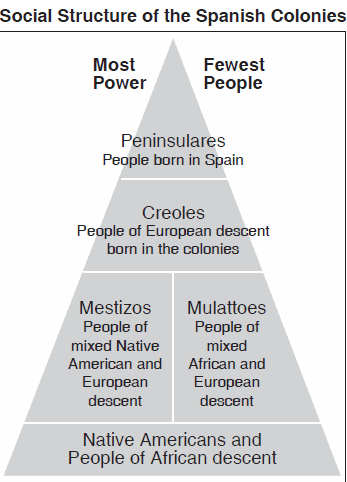
Summary:
Sea-based empires were led by Europe
advancement of maritime technology
found the Americas & began Columbian Exchange
disease, food, animals (horses), slaves
Atlantic Slave Trade was used for agricultural labor (chattel labor)
also used encomienda, hacienda, & mit’a system
Mercantilism was the dominant economic system (pie analogy)
led to colonial expansion for more resources & exports
trading-post empires (e.g. Brazil by the Portuguese)
funded by the states & joint-stock companies
New social hierarchies— American casta system
Unit 5
5.1– Enlightenment
Enlightenment– movement that emphasized the use of logic with natural laws
contrasted old idea of revelation/religion
Empiricism (Francis Bacon)– reality is understood through the senses
John Locke– natural rights, social contract
Enlightenment supported equal rights, which led to rebellion
also promoted nationalism
abolition of slavery & serfdom
Civil War, Russian serfs
women’s rights
Mary Wollstonecraft, Seneca Falls
Adam Smith wrote Wealth of Nations and argued for laissez-faire
Deism– idea of existence of God but not interference
Conservatives wanted to keep tradition & opposed enlightenment
5.2– Nationalism & Revolution
American Revolution was fueled by enlightenment
Declaration of Independence was filled with enlightenment ideas
French Revolution
Estates-general (clergy, nobility & commoners) didn’t properly represent the commoners
National Assembly was formed, stormed Bastille, rebellions led to more power in National Assembly
Declaration of the Rights of Man & Citizen limited monarchical power; led to Reign of Terror
Haitian Revolution
slave population took over from their owners
Toussaint L’ouverture led the rebellion
New Zealand War
Maori (natives) were oppressed by British & tried to fight back but failed
Latin America
creoles wanted to keep their profit & have more power
Simon Bolivar created Gran Columbia with enlightenment ideas
Nationalism led to unification
Italian Count Cavor wanted to join Italy and rule it
Otto von Bismarck founded the German empire
5.3– Industrial Revolution
making goods with machines to make labor more efficient
England began the Industrial Revolution
proximity to water (easy trade)
raw materials (coal & iron)
agricultural productivity (crop rotation, seed drill)
urbanization (population increased, but less labor needed on farms)
protection of private property (entrepreneurs could do more)
access to foreign resources (raw materials in colonies)
accumulation of capital (African slave trade, investing in new opportunities)
factory system (can produce goods on mass scale)
water frame + spinning jenny = faster production of textiles
Eli Whitney created interchangeable parts
5.4– Industrial Revolution Spreads
spread from England, through Europe, & to U.S./Russia/Japan
United States
European immigrants provided cheap labor (many Americans disliked immigrants)
Russia
building railroads led to increased trade— Trans-Siberian Railroad across Russia
steel industry grew
Japan
industrialized to protect their culture & keep away Western countries
5.5– Technology in Industrial Age
First Industrial Revolution— mid-1700s to mid-1800s
James Watt burned coal to power steam engines
factories could only be built near water, but steam engines could be built anywhere
steamships didn’t need the wind (increased trade)
locomotives could carry huge amounts of goods & people
Trans-Siberian & Trans-Continental Railroads
Second Industrial Revolution— late 1800s to early 1900s
steel was stronger & Bessemer Process could easily refine steel
oil wells for gas were drilled everywhere
kerosene was used for lamps & gasoline was used for internal combustion
harnessed electricity improved communications
telegraph & telephone
Effects
increased trade (easier transportation)
new ways of migration (easier travel & communication with home)
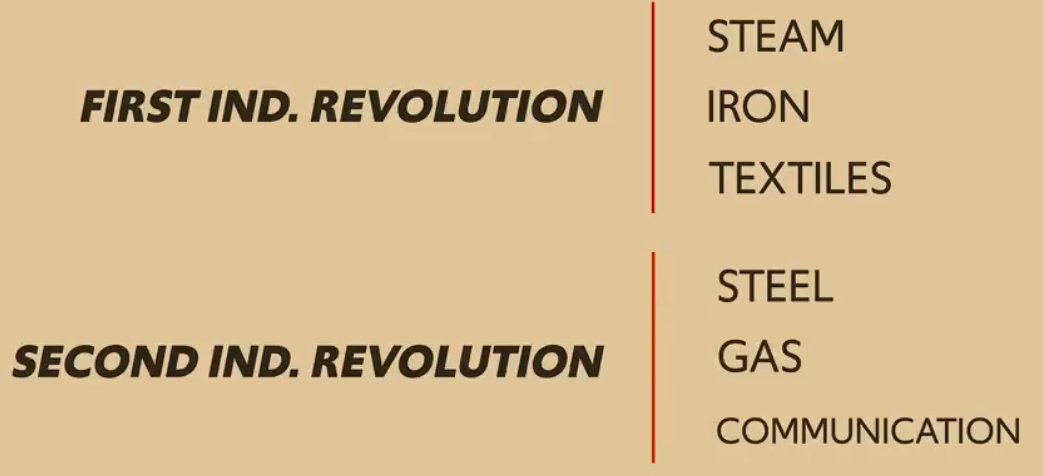
5.6– Government in Industrial Revolution
Ottoman Empire— “sick man of Europe”
surrounded by colonizers, non-industrial state, & weak leaders
Egyptian Muhammad Ali led the country into industrialization
Japan tried to isolate
United States tried to force Japan to open up to trade
Meiji Restoration— protected culture while industrializing
built roads, abolished feudalism, established constitutional monarchy
increased taxes
5.7– Economic Developments
Laissez-faire capitalism was favored over mercantilism
no limit to wealth, supply & demand, minimal government intervention
Corporations were like joint-stock companies but with limited liability (debts were limited)
Multinational corporations
Hong Kong & Shanghai Banking Co. used for trade after Opium Wars (British influence)
Unilever Corporation— Dutch & British produced household items through factories across nations
Consumer culture in middle class, better living conditions, advertising industry
Leisure culture— pubs, bikes, cock fighting, spectator sports
5.8– Reactions to Industrial Economy
Factory work had terrible conditions/wages
tenements were cramped living spaces
Labor unions— workers combined to gain freedom
gained 5 day work week, limits on hours, & minimum wage
bargained for franchise— right to vote
Child labor led to health issues
passed laws against child labor & for education
John Stuart Mill created utilitarianism
thought free market was selfish; actions should be carried out for benefit of whole, not individual
Karl Marx
bourgeoisie = upper class; proletariat = working class
capitalism harmed working class for success
Communist Manifest— workers should own means of production & share wealth equally
communism has no classes
Ottomans
Sultan Mahmoud II industrialized (abolished feudalism, built roads, established postal service)
Tanzimat reforms— equal law, remove corruption, secular schools
Sultan Abdul Hamid exiled the Young Turks (they wanted constitutional government) & killed the Armenians (wanted reform)
Qing Dynasty needed to modernize for stronger economy
Self-Strengthening Movement to preserve their culture while industrializing
lost the Sino-Japanese & began the 100 Days of Reform
abolished civil service exam & created industrial/commercial systems
conservative powers didn’t want to lose tradition
allowed Western powers to trade exclusively in exchange for help with industrialization
5.9– Society in Industrial Age
Cities changed
migrants increased populations drastically; led to bad living situations (tenements)
spread of disease (cholera)
middle class had better living standards —> white collar workers
Family structure changed
families used to work together on farms, now they went to their own jobs & spent less time together
fractured families
working women were in factories, but middle class women stayed home
Cult of Domesticity— women’s job is important (raising children & making things comfortable for the husband)
Seneca Falls Convention & other women’s rights movements
Environmental effects
fossil fuels created smog —> respiratory issues
waste polluted water supply
spread of diseases
Unit 6
6.1– Rationales for Imperialism
Culture
Europeans believed they had a superior culture and were required to spread it
“white man’s burden”
Darwinism— survival of the fittest
Social Darwinism— believed strong empires should take over the weak
Christianity wanted to convert everyone
missionaries established schools, hospitals, & abolished slave trade
Nationalism— a group of similar people are loyal to one state
Britain wanted to expand after losing America; India was crucial to them
France was in North/South Africa & Indochina
Japan wanted to expand into Korea
Sino-Japanese War —> Chinese lost
Economics
industrial economies needed raw materials & new markets
established trading posts & were allowed to defend them
powerful European armies took territory near their trading posts
6.2– State Expansion
Imperialism— a country extends its power/influence into other lands by diplomacy or force
Africa
European expansion was restricted in 1800s, but they wanted more land
British wanted a short route to Asia —> built Suez Canal in Egypt —> took the land from the Ottomans
Britain had agreements with African leaders, but decided to take over
France in West Africa established settler colony in Algeria
Scramble for Africa— everyone wanted land, Berlin Conference split up Africa
split up African groups & united rival groups
Belgian King controlled the Congo & was very brutal
Asia
British conquered India with their own troops & Indian troops called sepoys
economic imperialism in China
Chinese instability from natural disaster & internal conflict
Europe demanded trade with China —> spheres of influence
Japan became a colonizer
Meiji Restoration improved their military
Korea, Southeast Asia, China
Dutch tried to colonize Southeast Asia
Australia was a penal colony, New Zealand was a settler colony
Australia had lots of resources
New Zealand War with Maori
America
Indian Removal Act —> Trail of Tears
Manifest Destiny— it was their right to take the land
Spanish-American War won the U.S. the Philippines, Guam, Puerto Rico, & Cuba
Russia expanded, even into China
6.3– Indigenous Responses to State Expansion
natives had nationalism
Americas
Americans continued to expand —> Cherokee tried to assimilate —> gold was found and led to Indian Removal Act
Ghost Dance— wanted to get rid of the white men
Peru— Tupac Amaru revolted against Spain
Mexico— Benito Juarez dislike French —> the government joined the French to kick him out —> French were kicked out
Australian settlers were told to treat the natives well, but they pushed into their lands anyway
Africa
South African Xhosa people revolted against colonial governments run by Europeans —> Xhosa Cattle Killing Movement to drive out spirits
West Africa
Sokoto Caliphate fell
resistance to French— Samory Toure’s War
East Africa
Sudan resisted & beat the British— Mahdist Revolt
Balkans fought against the Ottomans & established new states
6.4– Global Economic Development
needed raw materials & food
Agriculture
cash crop farming promoted in Africa for exportation
increased demand for meat, new refrigeration technology
demand for fertilizer— guano
Raw materials
cotton— British cotton source shifted from America to Eygpt & India
rubber— used in everything, found in Amazon rainforest, natives used for labor
palm oil— West African oil was a lubricant
diamonds— Cecil Rhodes gained power through diamond trade in South Africa
increasingly interconnected global economy (manufactured goods & food)
weakening of colonial economy (cash crops harmed economy)
6.5– Economic Imperialism
when one country has significant economic power over another
Asia
India— British East India Co.
needed cotton exports
China— luxury goods
British wanted Chinese goods, but Chinese didn’t want British goods
led to little amounts of European silver
smuggled opium grown in India to addict Chinese —> Opium Wars —> China lost & opened more trade
Latin America
United States— Mexico, Cuba
Monroe Doctrine— U.S. controlled Western Hemisphere; Europeans were not allowed
invested in Latin America & gained trading partners
Britain invested in Argentina for trade
Spain— Chile had agriculture & copper
6.6– Causes of Migration
Labor systems
cash crop plantations needed labor, but there was a growing abolitionist movement
indentured servants sent money home & sometimes stayed in the new country, which influenced the local culture
Chinese & Indian contract labor had very low wages & bad conditions
penal colonies had convicts work on projects
Challenges
fled their home for better conditions, formed diaspora— a scattered population who originates from a different place
India, China, Ireland
Chinese worked on Trans-Continental Railroad
Irish fled famine & discrimination
Settler Colonies
many technical experts migrated to industrialize the colonies
Japan went to Mexico & Hawaii/Western U.S.
6.7– Effects of Migration
Home society
men left for work, so women had a bigger role
men either returned or brought their family later
Receiving society
spread of cultures created ethnic enclaves
Chinese influenced foods
Indians brought caste system, shrines,
kangani— whole families worked in Southeast Asia
Irish enclaves
lived in tenements, faced religious discrimination
music, dance, St. Patrick’s Day, Catholicism
labor unions
Italian enclaves
language was incorporated into Argentina
People didn’t like that jobs went to the immigrants
Chinese Exclusion Act & White Australia policy banned immigration
Other
Chinese Dynasties
Song Dynasty = Unit 1
Yuan Dynasty = Mongols
Ming Dynasty (reestablished China) 1350-1640
Qing/Manchu dynasty, 1640-1910-- not Chinese, but kept some Chinese institutions
 Knowt
Knowt
